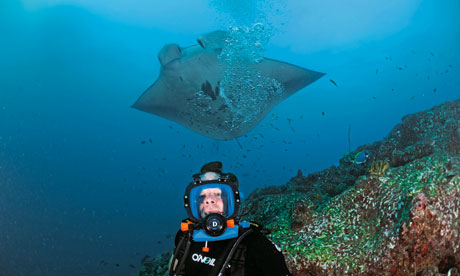Twenty-two years after first learning to dive, Hugh Fearnley-Whittingstall finally gets up close and personal with his hero animal

Everyone interested in wildlife dreams of an encounter with their hero animal. It might be an elephant, a leopard or a golden eagle. For those of us who love the underwater wilderness, it might be dolphins, sharks or a giant octopus. For me, obsessed with fish since I caught sticklebacks and kept them in a jam jar as a four-year-old, it's long been manta rays.
I learned to dive 22 years ago, in weekly sessions at a swimming pool in Swiss Cottage, north London. The most exciting things to see, apart from the black lines along the bottom of the pool, were matted balls of hair and the occasional discarded corn plaster. But from day one I was dreaming of swimming with mantas.
Since then, practically every foreign holiday I've taken has involved diving. I've dived in the Red Sea, in Thailand, in the Seychelles, in Madagascar, Mauritius and Tanzania. And I've dived on countless dive sites where seeing mantas was considered to be an occasional unexpected bonus – but always a long shot. And not once did I win the manta lottery. I've dived with sharks, played with octopuses and even snorkelled with whale sharks and basking sharks. They have all thrilled me. Not that I need the company of charismatic submarine megafauna to make a dive feel worthwhile. Seeing tiny wrasse busying themselves in the tentacles of sea anemones, or a velvet swimming crab waving its claws at me from its hidey-hole in a Dorset wreck is quite enough to send me back to my land world feeling privileged and content. But the manta itch has never been far away, and whenever I've arrived at a new destination, I've tentatively inquired whether mantas have been seen there in recent days/weeks/years/ever, often to be told, "You should have been here yesterday/last week/last month."
I went to the Maldives for the first time last September, to film pole and line tuna fishing as part of my new Channel 4 series, Hugh's Fish Fight. The story of mantas is relevant to the story of how tuna gets in a tin and ends up in a supermarket near you. This is partly because the vast majority of tinned tuna is caught by a method called purse seining. This involves huge boats putting out several kilometres of net, to surround a shoal of skipjack tuna. It's highly effective – even more so when the boats use something called a FAD.
A FAD is a fish aggregation device, which sounds pretty hi-tech, but in fact usually consists simply of a floating raft or a giant buoy, or collection of buoys, anchored to the sea floor. By simply being present in the open ocean, and an object of curiosity for passing marine life, FADs attract fish – including large shoals of skipjack. Unfortunately, they also attract many species that are not the target of the tuna fishermen, but will be caught in their nets anyway. Such casualties are called by-catch. Where FADs are used (and they are now used in the vast majority of fisheries that supply the UK with tinned tuna), the amount of unwanted by-catch increases from 1-2% of the catch to around 10%. Of particular concern to marine conservationists are the numbers of sharks, turtles and rays caught by this method. And oceanic manta rays fall victim to them, too.
By contrast, pole and line fishing is a remarkably clean method of catching tuna. By targeting a feeding shoal of skipjack, and presenting small, shiny hooks on a short line attached to a long pole, hardly anything except the tuna is ever caught. Turtles, sharks and rays are almost never killed.
What's remarkable about the Maldives is the way it has taken control of its marine resources and begun to manage them carefully for the benefit of the national economy and the local people. Foreign purse seining boats (most are owned by companies based in France and Spain) were banned from Maldivian waters by the country's first democratically elected president, Mohamed Nasheed, within months of his coming to power in late 2008. The Maldives' tuna resource is now exclusively fished by local boats using the pole and line method. This sustainable approach has encouraged supermarkets such as Sainsbury's, Marks & Spencer and Waitrose to reject the purse-seined tuna, and its controversial by-catch, and stock only pole and line-caught tuna. The pole and line-caught product is boldly labelled, and fetches a premium price – around £1.50 a tin, compared with 50p-£1 for the standard purse-seined tin. But the conscientious fish consumer is catching on and pole and line tuna sales are growing all the time.
There's only one other fish species that could arguably run the tuna close in its importance to the Maldivian economy – and that's the manta ray. Divers, who perhaps like me have begun to lose patience, or hope, for a chance encounter with a manta or two elsewhere in the world, book dive holidays in the Maldives on the understanding that seeing mantas is almost guaranteed – at least on certain sites at certain times of year. More than $8m a year are spent on manta dives and manta safaris, and that doesn't include hotel bookings and "live-aboard" boat accommodation.
And so I tumble over the side of the dive boat, above a reef that is known to be a manta cleaning station, where mantas come to have little parasites nibbled off them by obliging wrasse. I'm told that manta rays were seen here this very morning, and the day before, and every day before that for several weeks. I try not to think about probabilities, and to resist the mental torment that is so easily induced by the word "almost".
We swim down to a reef that is no more than 15 metres below the surface. It's pretty enough. There is plenty of fish life, including some engaging sweetlips, a plump, friendly reef fish with a stunning tiger-cross-leopard pattern of spots and stripes, yellow on brown. There's an almost preternaturally relaxed turtle that, when I get within touching distance, looks dolefully at me as if to say, "You're not really here to see me, are you?" But right now, there's not much else to look at. Or so it seems, in the glaring absence of manta rays. I'm in danger, I think to myself, of undermining my own mantra, that "there's no such thing as a boring dive". But try as I might, I just can't get engaged with the lovely local fauna. I'm too busy scanning the edge of my vision for some shape, some sign, that the biggest ray in the world is about to join us on the reef.
It doesn't happen. And I get to the point where I think there's clearly been a mistake. We're on the wrong reef. It's just too ordinary. Why would a manta come here? It's simply impossible to conceive of a creature of that size, and of that fabulousness, deigning to visit us on this very ordinary patch of rock and coral. After 45 minutes of this anguish, my air is running low, and it's time to head slowly up to the surface and return to the boat. My weak grin fails to hide my disappointment from my dive guide and the crew. "Nice turtle…" I manage to mutter as I climb up the ladder.
I am jinxed. Punished for some past act of fishy hubris. Perhaps I shouldn't be such an enthusiastic catcher and eater of fish. Perhaps I should never have imprisoned those sticklebacks in that jam jar… That night, I drink too much whisky. Descending to my cabin, I hear every creak and rattle of the gently rocking boat. It's too hot. I can't sleep. Where is my manta?
The next morning as the sun comes up at 6.30am, we're approaching the same reef. The usual pre-dive banter is absent as we pull on our gear. I back-roll into the water, working on an absence of thought, a total lack of anticipation, a readiness to focus on whatever comes my way, rather than straining to seek out something that simply isn't there.
The sun's still low, and down on the reef it's a little gloomier than it was the previous afternoon. I start to make friends with the sweetlips. As they hang above their favourite rock, I'm trying to engage their wary eyes with a little waggle of my finger. Behind them I notice a flutter of smaller fish rising off the reef, and I turn my attention to them.
I see it before I see it: a sultry, grey ghost-shape beyond the limit of clear vision. I'm still unpixellating it into the manta I so desperately want it to be, even as it reveals itself to be exactly that, with a slow beat of its extraordinary pointed wings that brings it effortlessly within a few metres. Ridiculously big, and impossibly graceful, it banks and turns within touching distance, just slowly enough for a dozen little cleaner wrasse to nuzzle up to its underside and start flitting around its broadly latticed gill-rakers, to take up their symbiotic task.
And then another looms into the light above the reef. And another. Soon, I am in a slow-motion vortex of six of these flying paradoxes of bulk and beauty, each one the size of three big dining tables bolted together, yet each as graceful and weightless as a kestrel in a light breeze.
No one is sure if mantas have been coming here for hundreds, thousands or hundreds of thousands of years, but the latter is a distinct possibility. Right here, right now, though, these creatures are impervious to my presence. And that is the essence of the thrill of being with them. It's a joy of a different order from playing with clever marine creatures such as dolphins and seals. Self-awareness is erased in the moment, lost in the pure pleasure of observing without influence the perfect action of a wondrous, unknowable being.
• Hugh Fearnley-Whittingstall flew to the Maldives with British Airways. Hugh's Fish Fight starts on Channel 4, Tuesday 11 January, at 9pm.

No comments:
Post a Comment